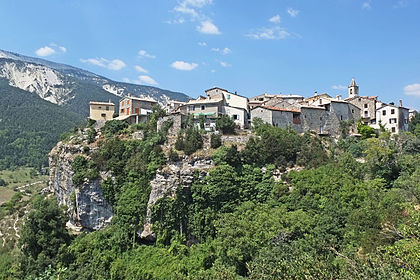At the very end of the Vaïre Valley, nestled on its promontory, Méailles, a perched village at 1050 meters altitude with its 80 inhabitants, is the final guardian of this valley before the railway tunnel leading to the Verdon Valley.
Travelers on the Train des Pignes can observe the watershed; while the Vaïre descends towards the southeast, after the tunnel, the Verdon flows towards the southwest. Let’s return to our small town. It is located along this railway line between two viaducts: the Moana and the Guillaumarse, both constructed between 1908 and 1910.
The Méailles station, opened on July 3, 1911, remained in service until February 1, 1953. Its management, including ticket sales, ticket punching, and handling of freight traffic mainly composed of the much-appreciated Méailles potatoes, was ensured by Madam Pons, the stationmaster. She also managed the level crossing protecting the road leading to the village.
Méailles, with the Barre caves inhabited since the Neolithic, is a very ancient settlement. With the Roman conquest by Augustus in 14 BC, Méailles came under the authority of Glanate, which became Glandèves. The first mention of the commune dates back to the 11th century: Maldagas successively came under the authority of the Pontevès, the Glandèves, and the Villeneuves. With the cession of the County of Nice to the Savoys, Méailles was transferred from the judicial district of Puget-Théniers to that of Annot. The revolution and the empire allowed for the development of the village’s cadastral map, which was completed in 1830. The Colle tunnel, nearly 4 kilometers long, connected Méailles to Digne in 1903.
The Vaïre Valley is bordered by Mont Ruch to the east, peaking at 2099 meters, and to the west by Puy de Rent, separating it from the Verdon at 1974 meters. Three religious edifices invite visitors to pray: the Saint Joseph chapel to the south, the Notre Dame church in the center of the village supposedly with a double dedication, with Saint James, the patron saint of Méailles, being mentioned.
With its 12th-century Romanesque nave, it was expanded in the 14th and 15th centuries. The last chapel, located to the north on a mound, is dedicated to Saint James. It offers a vantage point over the Vaïre Valley and the plateau where agricultural activities continue the renown of Méailles and its potatoes. As you wander the streets of this village, you’ll be struck by its massive stone houses and narrow alleys.
A large stone archway, resembling an ancient gate, and the name of a street suggest the past existence of a castle. Méailles, with its 80 inhabitants, is preserved from tourist crowds; the village has retained its soul, which is its main charm.
Thierry Jan


